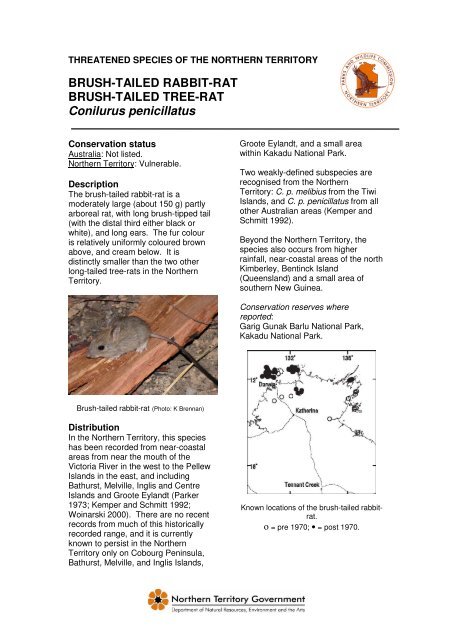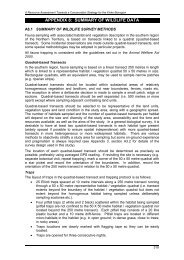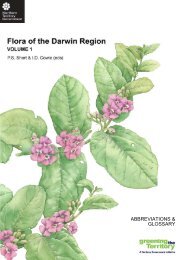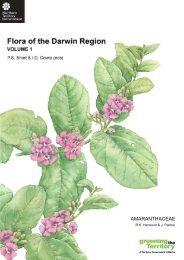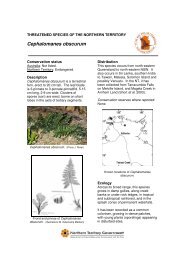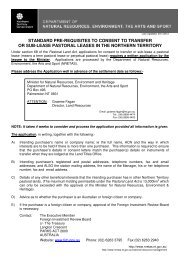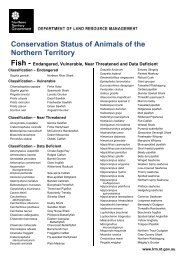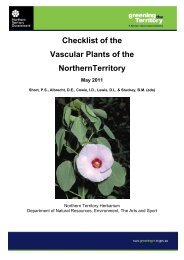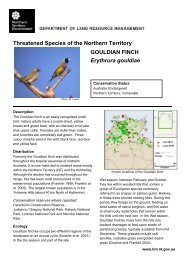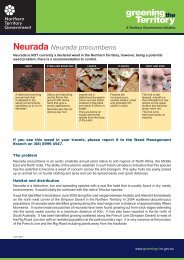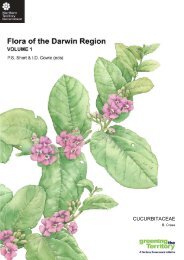BRUSH-TAILED RABBIT-RAT BRUSH-TAILED TREE-RAT ...
BRUSH-TAILED RABBIT-RAT BRUSH-TAILED TREE-RAT ...
BRUSH-TAILED RABBIT-RAT BRUSH-TAILED TREE-RAT ...
You also want an ePaper? Increase the reach of your titles
YUMPU automatically turns print PDFs into web optimized ePapers that Google loves.
THREATENED SPECIES OF THE NORTHERN TERRITORY<br />
<strong>BRUSH</strong>-<strong>TAILED</strong> <strong>RABBIT</strong>-<strong>RAT</strong><br />
<strong>BRUSH</strong>-<strong>TAILED</strong> <strong>TREE</strong>-<strong>RAT</strong><br />
Conilurus penicillatus<br />
Conservation status<br />
Australia: Not listed.<br />
Northern Territory: Vulnerable.<br />
Description<br />
The brush-tailed rabbit-rat is a<br />
moderately large (about 150 g) partly<br />
arboreal rat, with long brush-tipped tail<br />
(with the distal third either black or<br />
white), and long ears. The fur colour<br />
is relatively uniformly coloured brown<br />
above, and cream below. It is<br />
distinctly smaller than the two other<br />
long-tailed tree-rats in the Northern<br />
Territory.<br />
Brush-tailed rabbit-rat (Photo: K Brennan)<br />
Distribution<br />
In the Northern Territory, this species<br />
has been recorded from near-coastal<br />
areas from near the mouth of the<br />
Victoria River in the west to the Pellew<br />
Islands in the east, and including<br />
Bathurst, Melville, Inglis and Centre<br />
Islands and Groote Eylandt (Parker<br />
1973; Kemper and Schmitt 1992;<br />
Woinarski 2000). There are no recent<br />
records from much of this historically<br />
recorded range, and it is currently<br />
known to persist in the Northern<br />
Territory only on Cobourg Peninsula,<br />
Bathurst, Melville, and Inglis Islands,<br />
Groote Eylandt, and a small area<br />
within Kakadu National Park.<br />
Two weakly-defined subspecies are<br />
recognised from the Northern<br />
Territory: C. p. melibius from the Tiwi<br />
Islands, and C. p. penicillatus from all<br />
other Australian areas (Kemper and<br />
Schmitt 1992).<br />
Beyond the Northern Territory, the<br />
species also occurs from higher<br />
rainfall, near-coastal areas of the north<br />
Kimberley, Bentinck Island<br />
(Queensland) and a small area of<br />
southern New Guinea.<br />
Conservation reserves where<br />
reported:<br />
Garig Gunak Barlu National Park,<br />
Kakadu National Park.<br />
Known locations of the brush-tailed rabbitrat.<br />
ο = pre 1970; • = post 1970.
Ecology<br />
The preferred habitat of the brushtailed<br />
tree-rat is eucalypt tall open<br />
forest (Firth et al. 2006a) . However, at<br />
least on Cobourg Peninsula, it also<br />
occurs on coastal grasslands (with<br />
scattered large Casuarina equisetifolia<br />
trees, beaches, and stunted eucalypt<br />
woodlands on stony slopes (Frith and<br />
Calaby 1974; PWCNT 2001).<br />
It shelters in tree hollows, hollow logs<br />
and, less frequently, in the crowns of<br />
pandanus or sand-palms (Firth et al.<br />
2006b). Most foraging is on the<br />
ground, but it is also partly arboreal.<br />
The diet comprises mainly seeds<br />
(especially of grasses), with some<br />
fruits, invertebrates and leaves and<br />
grass (Firth et al. 2005).<br />
Conservation assessment<br />
Conservation assessment is<br />
hampered by lack of knowledge<br />
concerning the timing, extent and<br />
currency of geographic decline, and<br />
the lack of a comprehensive recent<br />
assessment of their status on Groote<br />
Eylandt and Centre Island. Relatively<br />
brief recent (2003-2005) surveys failed<br />
to re-locate the species on Centre<br />
Island (Taylor et al. 2004; S. Ward<br />
pers. comm.), but reported one<br />
individual on Groote Eylandt (D. Milne<br />
pers. comm.). Its range and<br />
population size in the Northern<br />
Territory has probably declined by well<br />
over 50% since European settlement,<br />
but this decline cannot be dated with<br />
any assurance. Certainly, its current<br />
status no longer matches that reported<br />
more than 100 years ago: “in Arnhem<br />
Land is everywhere common in the<br />
vicinity of water” (Dahl 1897),<br />
“numerous all over Arnhem Land, and<br />
in great numbers on the rivers of the<br />
lowlands” (Collett 1897). There is<br />
some suggestion of a decline within<br />
the last 20 years at Kakadu National<br />
Park, but this is based on very few<br />
records (Woinarski et al. 2001).<br />
Current research will provide some<br />
assessment of the population size (or<br />
Threatened Species Information Sheet<br />
at least an index of abundance, whose<br />
assessment can be consistently<br />
repeated) on Bathurst and Melville<br />
Islands, Cobourg Peninsula and<br />
Kakadu. A recent study (PWCNT<br />
2001) found very high population<br />
density (>6 individuals/ha) in at least<br />
two locations on Cobourg Peninsula.<br />
Its status best fits Vulnerable (under<br />
the criteria B1ab(i,ii,iii,iv,v) based on:<br />
• extent of occurrence estimated to<br />
be
may have changed the availability of<br />
preferred or vital food resources (e.g.<br />
seeds or stems from particular grass<br />
species), and more frequent hot fires<br />
may have reduced the availability of<br />
hollow logs, tree hollows and the tall<br />
fruit-bearing understorey shrubs, and<br />
unfavourably changed the composition<br />
of grass species (Woinarski et al.<br />
2004; Firth et al. 2005, 2006b).<br />
The population on the Tiwi Islands has<br />
been substantially reduced by recent<br />
clearing for forestry plantation of about<br />
30,000 ha of its prime habitat (Firth et<br />
al. 2006a); and there are proposals to<br />
extend this forestry enterprise up to<br />
100,000 ha.<br />
Conservation objectives and<br />
management<br />
There is no existing recovery plan or<br />
management program for this species.<br />
In the interim, management priorities<br />
are to:<br />
(i) maintain a monitoring program in at<br />
least two sites, which can also<br />
measure responses to management<br />
actions. The baseline for this<br />
monitoring has now been established,<br />
with recent studies on Cobourg<br />
Peninsula, the Tiwi Islands and in<br />
Kakadu National Park.<br />
(ii) work with Aboriginal landowners to<br />
maintain effective quarantine actions<br />
for island populations, most<br />
particularly relating to maintaining at<br />
least some of these islands cat-free.<br />
(iii) develop effective captive<br />
population breeding programs, and<br />
evaluate the possibility of establishing<br />
translocated populations (either to<br />
currently uninhabited islands or to<br />
appropriately managed conservation<br />
reserves). Such a program is currently<br />
being undertaken through the Territory<br />
Wildlife Park.<br />
(iv) ensure that habitat clearance for<br />
plantation forestry on the Tiwi Islands<br />
does not compromise population<br />
viability.<br />
Threatened Species Information Sheet<br />
Compiled by<br />
John Woinarski<br />
[January 2007]<br />
References<br />
Collett, R. (1897). On a collection of<br />
mammals from North and North-west<br />
Australia. Proceedings of the<br />
Zoological Society of London 1897,<br />
317-336.<br />
Dahl, K. (1897). Biological notes on<br />
north-Australian mammalia.<br />
Zoologist, Series 4, 1, 189-216.<br />
Firth, R.S.C., Jefferys, E., Woinarski,<br />
J.C.Z., and Noske, R.A. (2005). The<br />
diet of the brush-tailed rabbit-rat<br />
Conilurus penicillatus from the<br />
monsoonal tropics of the Northern<br />
Territory, Australia. Wildlife Research<br />
32, 517-524.<br />
Firth, R.S.C., Woinarski, J.C.Z., Brennan,<br />
K.G., and Hempel, C. (2006a).<br />
Environmental relationships of the<br />
brush-tailed rabbit-rat Conilurus<br />
penicillatus and other small mammals<br />
on the Tiwi Islands, northern<br />
Australia. Journal of Biogeography<br />
33, 1820-1837.<br />
Firth, R.S.C., Woinarski, J.C.Z., and<br />
Noske, R.A. (2006b). Home range<br />
and den characteristics of the brushtailed<br />
rabbit-rat Conilurus penicillatus<br />
in the monsoonal tropics of the<br />
Northern Territory, Australia. Wildlife<br />
Research 33, 397-408.<br />
Frith, H.J., and Calaby, J.H. (1974).<br />
Fauna survey of the Port Essington<br />
district, Cobourg Peninsula, Northern<br />
Territory of Australia. Technical<br />
Paper no. 28. (CSIRO Wildlife<br />
Research, Canberra.)<br />
Kemper, C.M., and Schmitt, L.H. (1992).<br />
Morphological variation between<br />
populations of the brush-tailed treerat<br />
(Conilurus penicillatus) in northern<br />
Australia and New Guinea.<br />
Australian Journal of Zoology 40,<br />
437-452.<br />
Parker, S.A. (1973). An annotated<br />
checklist of the native land mammals<br />
of the Northern Territory. Records of<br />
the South Australian Museum 16, 1-<br />
57.<br />
PWCNT (2001). Studies of the brushtailed<br />
tree-rat Conilurus penicillatus in<br />
Gurig National Park. (PWCNT,<br />
Darwin.)<br />
Taylor, R., Woinarski, J., Charlie, A.,<br />
Dixon, R., Pracy, D., and Rhind, S.
(2004). Report on mammal survey of<br />
the Pellew Islands 2003.<br />
(Lianthawirriyarra Sea Ranger Unit,<br />
Department of Infrastructure,<br />
Planning and Environment, and<br />
Tropical Savannas CRC, Darwin)<br />
Woinarski, J.C.Z. (2000). The<br />
conservation status of rodents in the<br />
Top End of the Northern Territory.<br />
Wildlife Research 27, 421-435.<br />
Woinarski, J.C.Z., Milne, D.J., and<br />
Wanganeen, G. (2001). Changes in<br />
mammal populations in relatively<br />
intact landscapes of Kakadu National<br />
Park, Northern Territory, Australia.<br />
Austral Ecology 26, 360-370.<br />
Woinarski, J.C.Z., Armstrong, M., Price,<br />
O., McCartney, J., Griffiths, T., and<br />
Fisher, A. (2004). The terrestrial<br />
vertebrate fauna of Litchfield National<br />
Park, Northern Territory: monitoring<br />
over a 6-year period, and response to<br />
fire history. Wildlife Research 31, 1-<br />
10.<br />
Threatened Species Information Sheet


